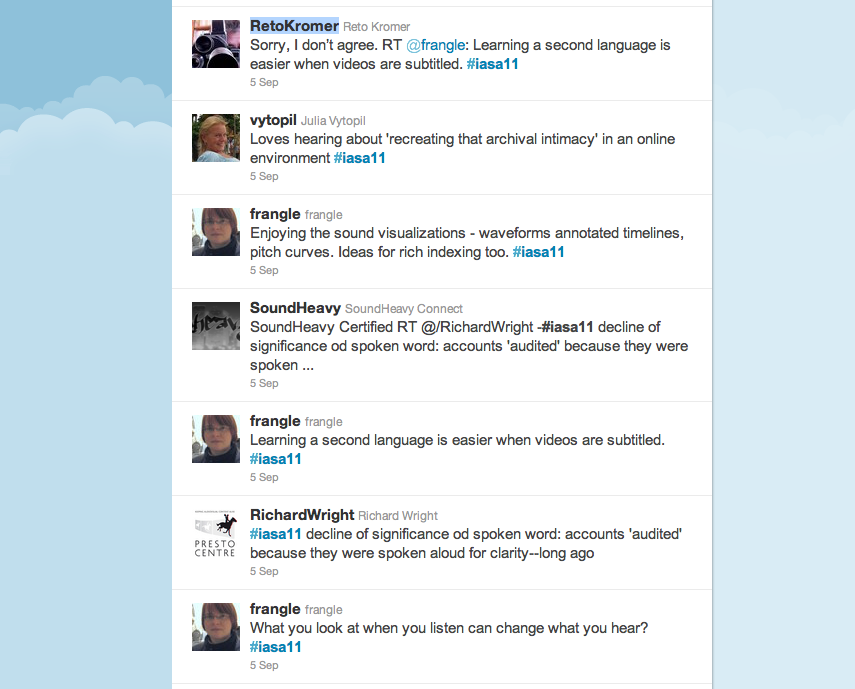42nd Annual Conference
Digital Sense and Nonsense: Digital Decision Making in Sound and Audiovisual Collections
Frankfurt, Germany, 3-8 September 2011
hashtag: #iasa11
Annie Murray & Jared Wiercinski (Concordia University)
September 5, 2011
Presentation slides available at: http://goo.gl/370×0

We presented on the first day of the conference and our session was moderated by Richard Ranft, Head of Sound and Vision at the British Library. We had interesting questions and good feedback after our presentation. One question was about poetic speech being available as text and if the versions of the spoken poem could be compared to the published versions. Another was about just listening, and whether too many visual features might clutter the site and distract from the sound. We anticipated this in our paper and replied that it would depend on the stage and nature of research, so it is important to have a flexible site that allows people to select or deselect visual features. In an informal discussion following the paper, we talked about the need for common tools and standards for annotating audio recordings. One researcher suggested that a W3C standard should be developed. Several conference participants also tweeted about our presentation, which we captured here:
We learned about a few new projects and trends in web development that might be relevant for the next SSHRC application, especially concerning the research axis we tentatively labelled “New technologies for spoken word capture and dissemination”. 2 projects from the British Library are UK SoundMap and Evolving English. These projects from the British Library involved inviting participants (i.e., “crowdsourcing”) to record either ambient sounds or speech, respectively, using mobile phones that have the free Audioboo app installed. The Audioboo software automatically adds metadata to the file (e.g., time and geolocation of the recording, using information from the mobile phone) and uploads it to the Audioboo site. As long as participants had tagged their recording in a specific way, the British Library was able to harvest the recording and make it available through their own site. Interestingly, Sheffield University is already using material from the Evolving English project for research on English dialects. We thought this was a nice demonstration of how these new mobile audio recording and publishing technologies are already being used, and how they are generating recordings that are useful for new research.
Another new technology and increasingly important web development that may be worth exploring in the next phase of the project (and therefore, in the upcoming grant application) is the semantic web (or Web 3.0). It doesn’t have to be a significant aspect, but perhaps just mentioning it in some minor way (e.g., in the same way we mentioned HTML 5 in our previous grant) will be enough.
Here are 2 (very) short blurbs on the semantic web:
“The Semantic Web is about two things. It is about common formats for integration and combination of data drawn from diverse sources, where on the original Web mainly concentrated on the interchange of documents. It is also about language for recording how the data relates to real world objects. That allows a person, or a machine, to start off in one database, and then move through an unending set of databases which are connected not by wires but by being about the same thing.” (source)
“What the Semantic Web offers, essentially, is a social and technical context for building a federated metadata database from a set of independent databases.” (source)
To relate this more concretely to our project, it strikes us that developing Canadian poetry sites with an eye towards the semantic web might make it easier for researchers to discover work by or about a particular poet that is distributed in more than one digital archive or web site.
Also, another relevant semantic web-ish development is the Text Encoding Initiative:
The TEI Guidelines for Electronic Text Encoding and Interchange define and document a markup language for representing the structural, renditional, and conceptual features of texts. They focus (though not exclusively) on the encoding of documents in the humanities and social sciences, and in particular on the representation of primary source materials for research and analysis. (source)
Here is an answer to the question: “What can I do with my TEI-encoded text?”
TEI markup supports a wide range of useful functions including online publication, searching, text analysis, and conversion into other formats. There are many tools for manipulating, presenting and querying XML documents available. (source)
Some interesting TEI-related things we’ve come across:
- TokenX: a text visualization, analysis, and play tool
- A poetry visualization tool
- An issue of the Poetess Archive Journal dedicated to the topic of “Visualizing the archive”
- A few examples of papers from this issue:
Finally, we learned about initiatives at various organizations, especially in Europe. At the Netherlands Institute for Sound and Vision, much audiovisual content is made freely available on the web. We also learned about EUScreen which is an aggregator of European TV programs. The Director of Europeana, Jill Cousins, spoke about Europeana’s strategic directions. We learned about different sites in India that gather archival media footage for creative re-use and the question of how social media will be archived was raised. We noted that many big organizations and broadcasters are grappling with huge digitization projects to safeguard national heritage on radio and television. If you are interested in hearing more about the papers, let us know. The program is available at: http://www.iasa-conference.com/programme.
